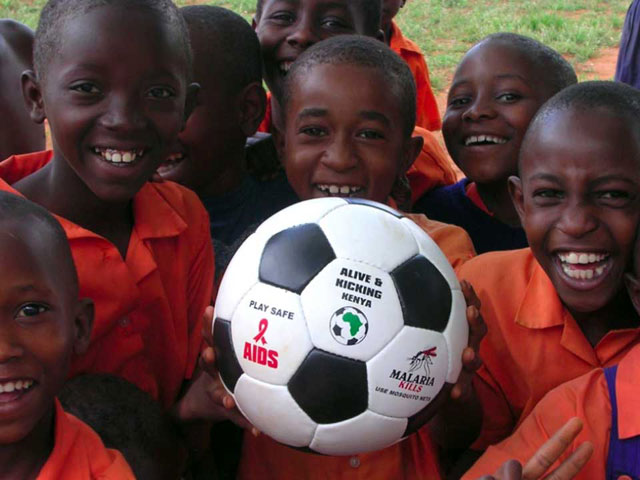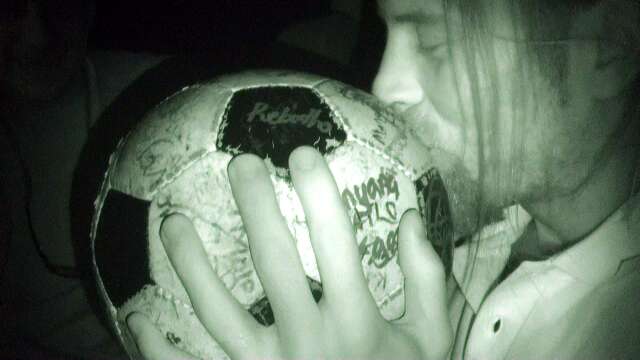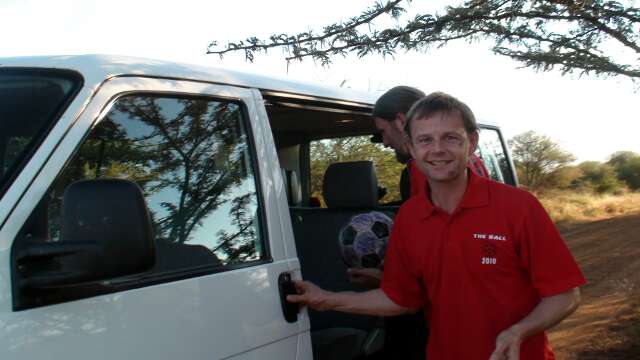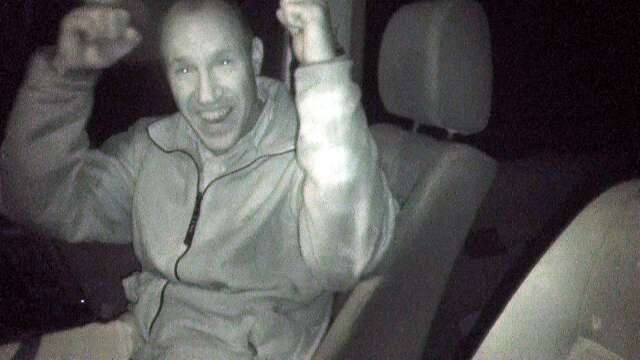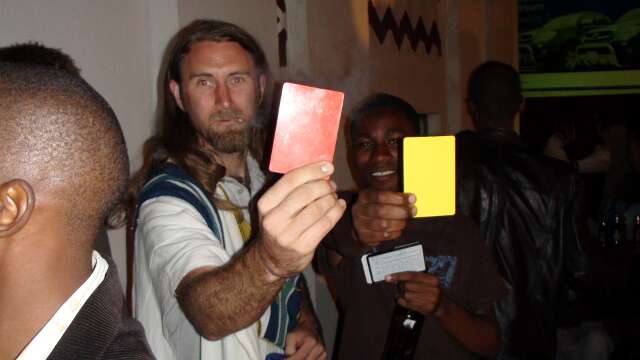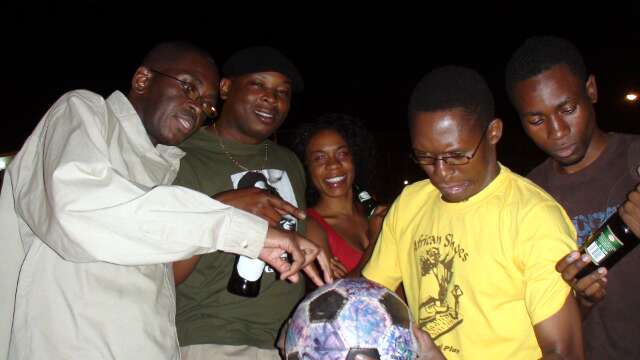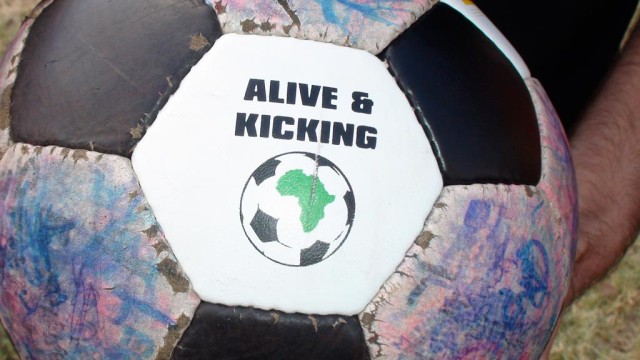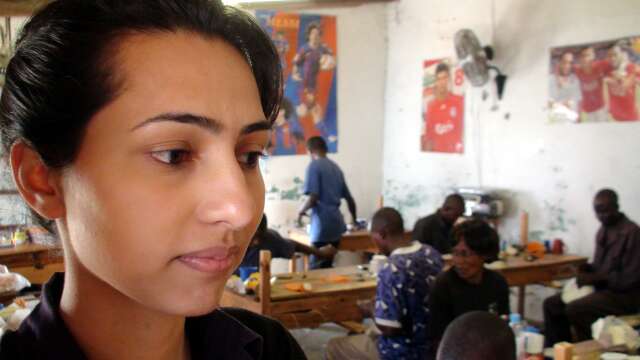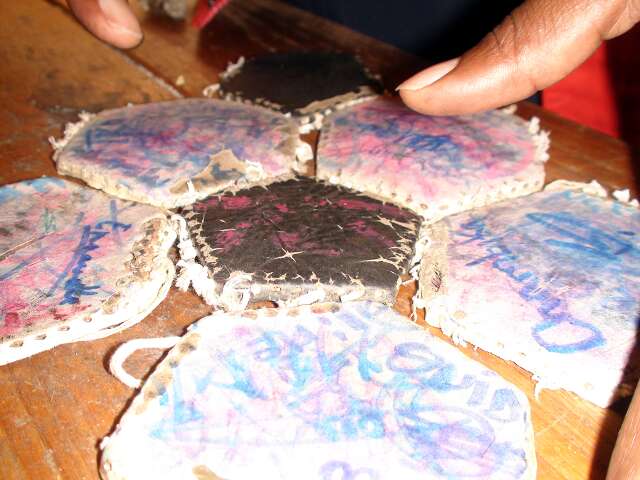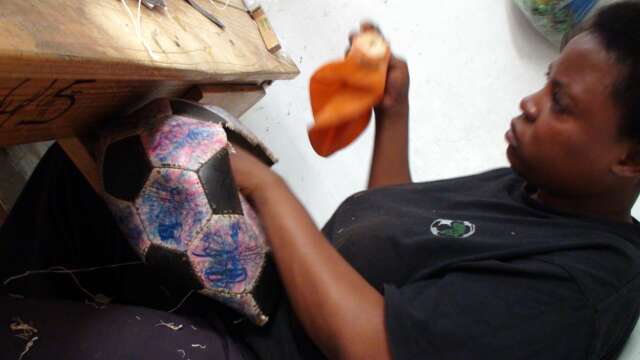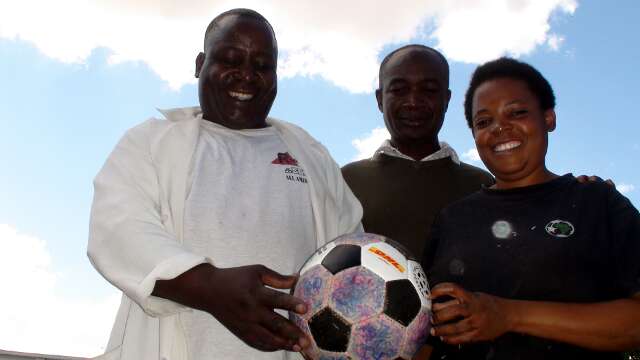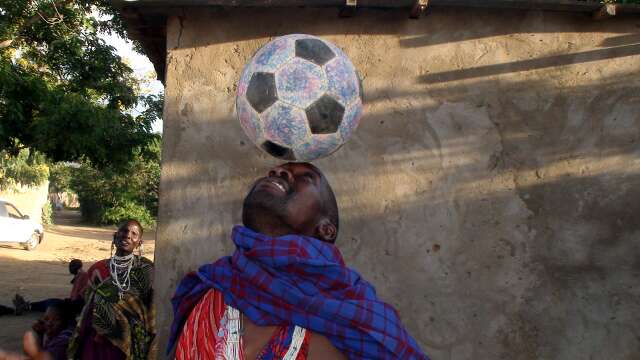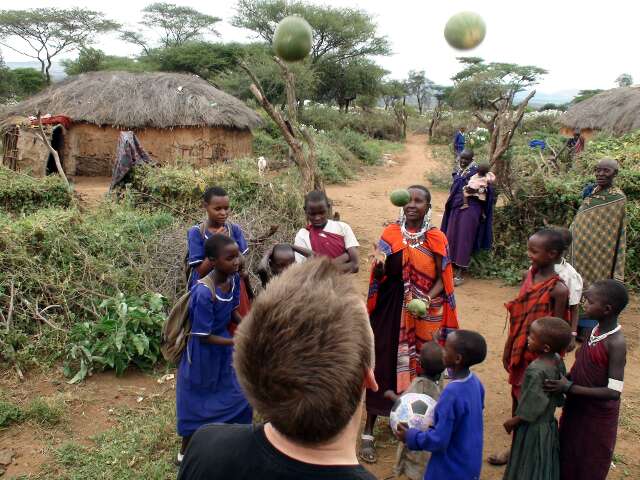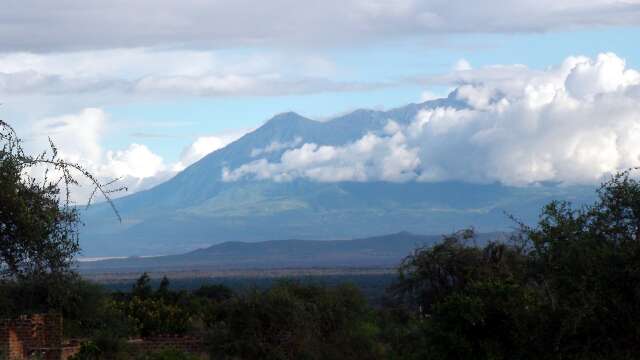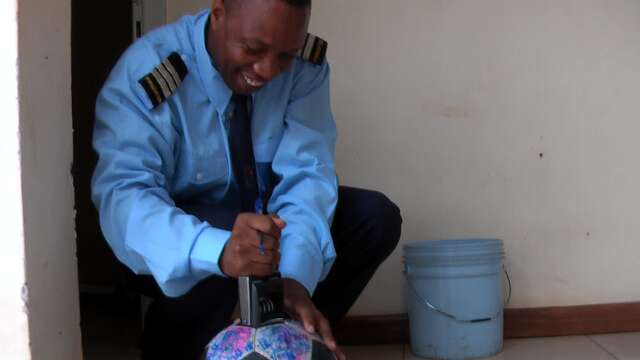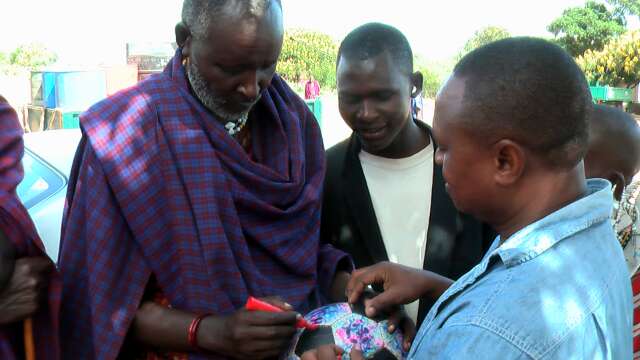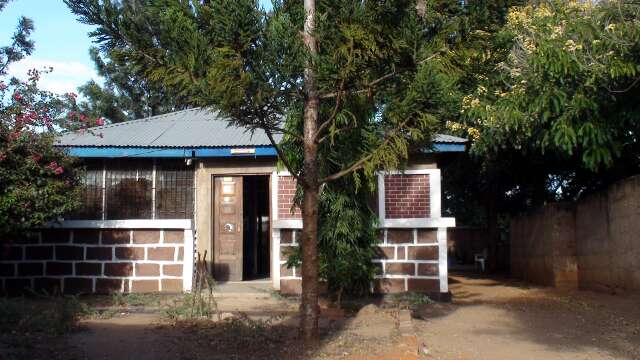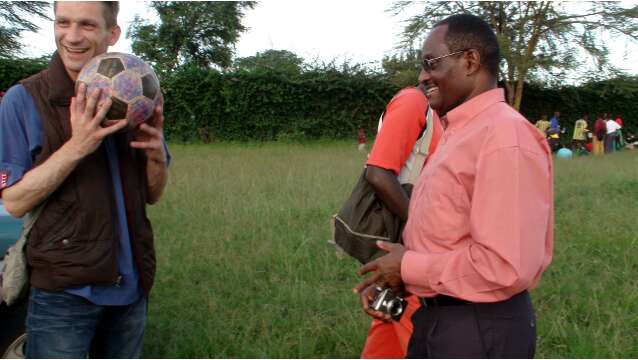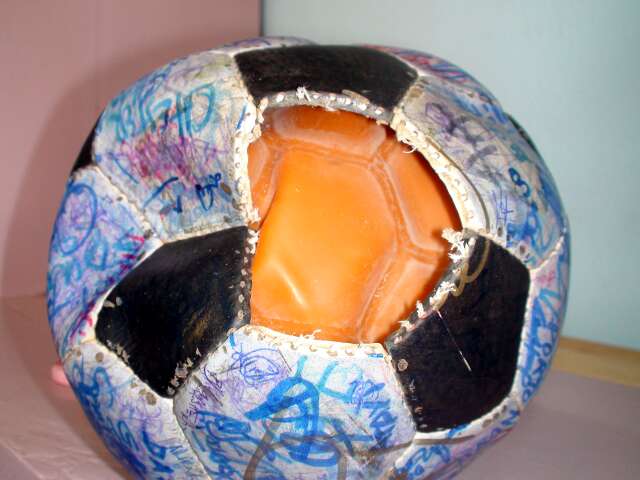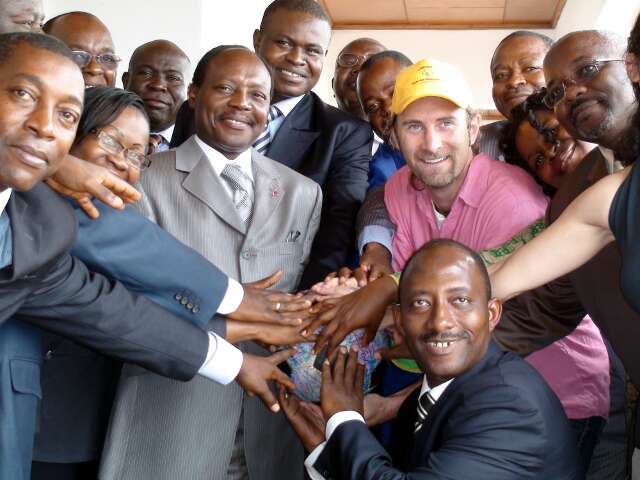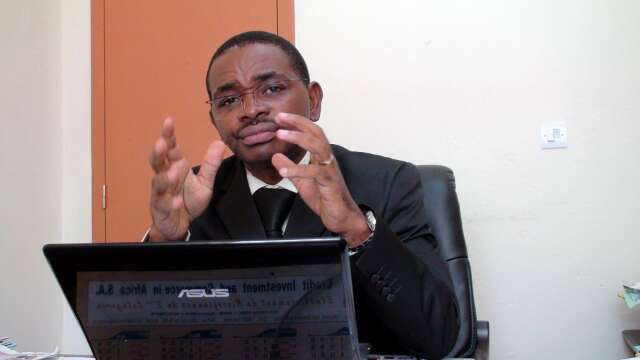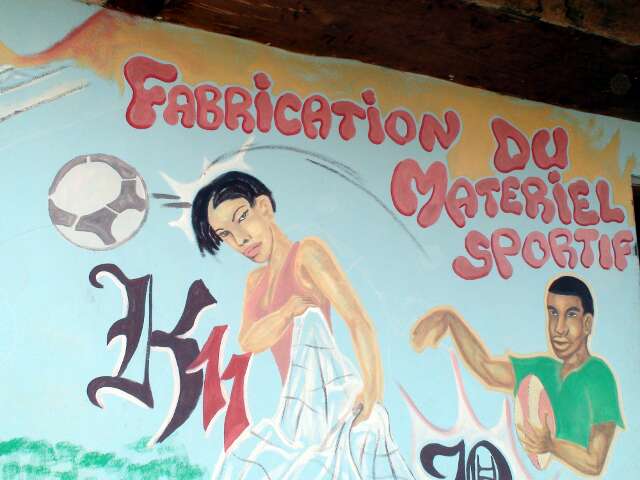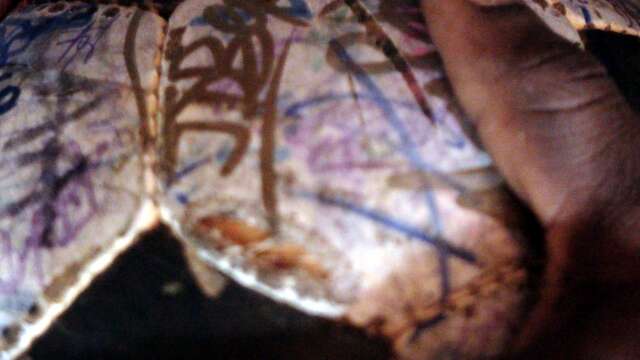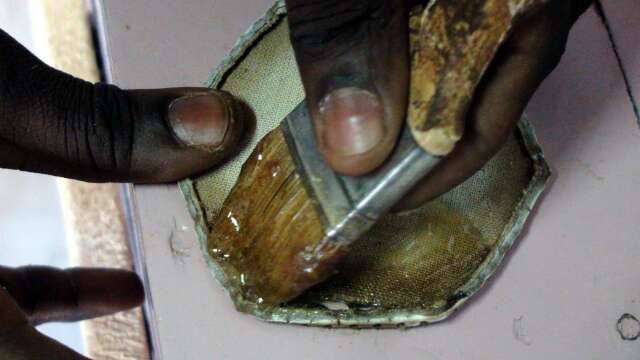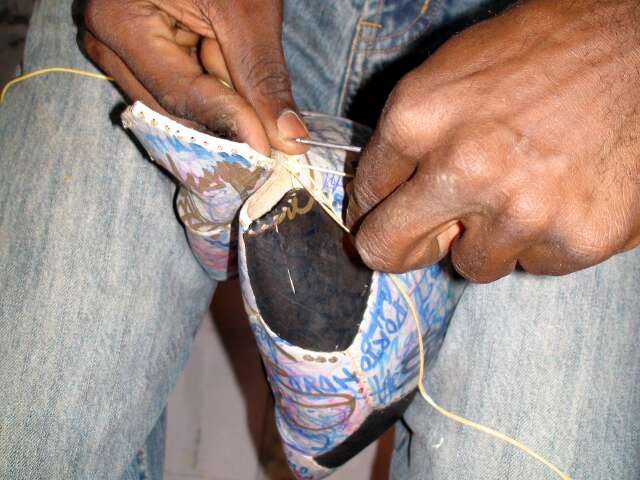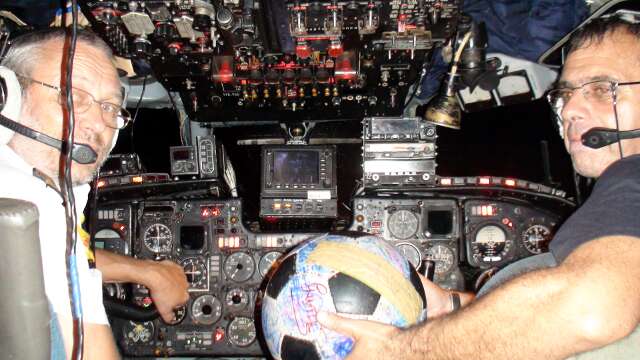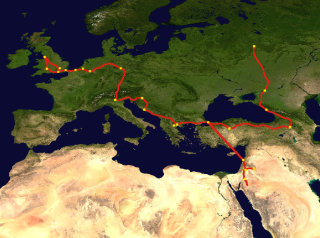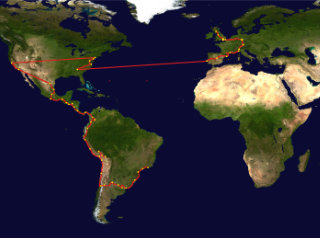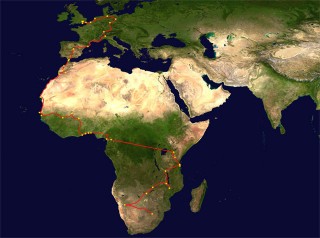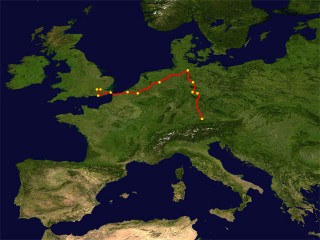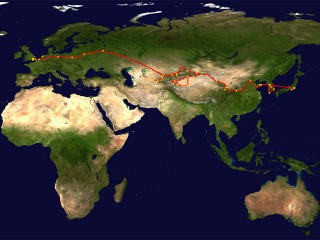We enter South Africa in the late afternoon and pull over around 7pm near Rustenburg to do a live interview with the BBC World Service. Andrew speaks to the World Service, in the dark on a road through big 5 safari land, about the elation of arriving in South Africa, the 32nd and final country.
As Andrew speaks on the phone, Christian star gazes outside. We leave that random spot and head for Johannesburg. As we arrive later at a toll booth, Christian suggests that the toll booth attendant sign The Ball.
What ball? We realise we are missing something…. something very important… The Ball! It has somehow rolled out of the van. Panic. We search the van high and low. Andrew is beside himself. In 131 days to date The Ball has hardly left his sight. His reoccuring dream of The Ball being lost is suddenly a reality.
Richard, our driver, calms the situation: “I know where we stopped. We’ll find it.”
Andrew is not so sure. He’s starting to dream up a rescue operation that would include national guard troops and radio stations. He’s imagining us spending the rest of our time in SA looking for The Ball. Phil turns the video camera on and films as the action unfolds.
In the dark, in total stress, we turn back, hunting The Ball.
“That looked like something, over there” says Christian. So we turn around and slowly comb the roadside’s grassy fringe.
“It’s The Ball” screams Phil. “It’s The Ball!” And he bounds out of the van… and holds The Ball aloft. “Andrew, give that ball a kiss and promise you’ll never let it out of the net again.” Andrew roars with relief and kisses it.
Four grown men embrace. Close to tears…it’s a moment of pure emotion, pumped up with adrenalin and smoothed by Klipdrift – South African brandy.
What panic. What ecstasy.
The Ball is here.
Long live The Ball.
There is only one Ball.
One Ball. One World.
Mosi, Mosi, Mosi, Mosi. It seems like Zambia has been one long, cold Mosi.
The Zambians love to party. They love to entertain. They love to have a good time. And they love to drink Mosi. Weekend in Zambia means Mosi for breakfast. Mosi for lunch. Mosi for dinner.
Not wanting to let our hosts down, we climb on board the Mosi train.
Mosi. Mosi. Mosi. Mosi.
The Ball’s been on the road for well over one hundred days now. Its been played in perhaps seven hundred kick-abouts — on streets, in parks, it even joined the mile-high kick club when it was kicked by pilots in the cockpit en route to Lagos. The Ball has been around the block and it’s starting to look a little worse for wear. Luckily, our partner Alive & Kicking has a stitching centre in Lusaka.
Christian hasn’t seen The Ball being operated on. And the anguished look on his face as The Ball doctor opens The Ball up is one that any worried parent can relate to. His eyes bulge, his mouth gapes… he looks white as a sheet (well, he always does — he’s English).
Before long, five panels have been removed.
The Ball doctor still isn’t satisfied and looks to get cracking on the bladder. “Stop! Please. Now”, says Christian. She does.
We’ve brought a bladder and a few spare panels from Nairobi. Alive and Kicking provide a few Zambian panels too. The Ball is becoming more African by the day!
The operation is a success but The Ball looks very strange. Even stranger than it did in Nairobi after having 2 panels replaced. The Ball looks rather like the result of a serious head-on ball collision. Two balls have merged into one.
It is going to take a live kicking or ten before The Ball can bounce evenly again.
We aren’t doing the “please pose for photos” thing, like most tourists would probably tend to do with the Maasai. They seemed to be quite intrigued by The Ball and why we’re filming it in all kinds of crazy locations. There is often a real conflict here generated by the tourist thing that people do — trundling in with their cameras, have the locals pose for pictures and then trundling off again.
We weren’t expecting them to warm to us as they have done. The first day we were here in Longido, the Maasai kept their distance. It was the locals who were playing with us. The Maasai appear to be cautious people. But we can understand their caution. Perhaps they saw that we are here to have fun. And they understand this. We are not parachuting in and trying to come to terms with and understand their culture in a matter of hours. That is simply not possible. We don’t have the time to do a proper ethnography or cultural study. And this is not our mission anyway.
We have brought something tangible, something unique and something magical to them. They took their time in the first few days of our visit. They sussed us and our strange ball out. It has been a lovely introduction to Tanzania. This has been really special arriving here incognito. And still the spirit of The Ball shines through.
The more I think about it. The more respect I have for the Maasai. They have greeted us with friendship and not with “one picture 10 dollars, come on my tour.” They have just invited us into their homes and invited us to play football with them and helped us to kick The Ball onwards to South Africa and done so with a real spirit. The Spirit of Football perhaps.
The Mondo Challenge Foundation crew whizz into town: They are on a mission. Their uniforms, bright yellow polo shirts, are the first thing that we see. Mondo’s Director, Anthony Lunch takes charge: ordering food, sending a messenger running to find Mr. Alliy and organising a kick-about on the street with locals from a Maasai tribe. It’s a feverish pace.
We are glad to see how motivated Mondo’s Directors are and we find out about the projects they are funding. Anthony tells us about Mondo’s hectic schedule — meetings this morning in Longido, this afternoon and tomorrow in Arusha and the following days in Moshi at the foot of Kilimanjaro… then back to the UK. A whirlwind tour. They have no time to waste and are incredibly precise about the money they invest and the return on that investment in terms of quality of help. And before we can blink (or even snap a photo of them) they are off again.
Alliy Mwako arrives, beaming a huge smile, and makes us feel most welcome. He immediately understands what The Ball is about and begins to suggest an itinerary. We’ll stay in his guest house and play football this evening. The biggest bonus for Andrew -– Alliy’s a fervent Liverpool fan too.
All this action is foreign to this sleepy, out of the way corner of the world, tucked in at the foot of idyllic, tree-covered Mt Longido, not far from the Kenyan border. The view of the more distant Mt Meru is spectacular.
Unusually, the people here leave us alone. We’re not being inundated with requests. No one is trying to sell us paintings or phone cards or children’s shoes or even shoe polish. Instead, we are looked at, stared at even… who are these guys? What about that ball full of signatures? Perhaps suspicions have been aroused. We are keen to find out more about this town.
Africa is feared for its viruses, but we weren’t expecting to succumb to the digital kind. But that’s exactly what has befallen us here in Kenya. We have a laptop running Windows XP which has just died of its infection.
Christian sits there, holding his head in his hands, staring at the machine. He’s wishing he had been more decisive and installed Ubuntu on the thing the moment he saw it was running Windows. And now the viruses have gone and corrupted the only copy of the Ubuntu installer. He can’t decide whether to laugh, cry or scream.
“Oh well,” he thinks to himself, “at least Andrew’s volunteered to carry it until it can be fixed!”
FLASH FORWARD: its just been fixed here in Lusaka, running a shiny new version of Ubuntu, which rocks. Perhaps we now stand a chance of catching up on this blog before we reach South Africa.
England, Somerset, Radstock, Tuesday evening. I walk downstairs after settling my son, Alistair, in his bed for the night. I have resigned myself to my scheduled flight to Kenya being cancelled indefinitely by the intervention of the Icelandic volcano. The TV is showing the news. My attention is suddenly grabbed. Flights are back on — and mine appears to be one of them. With a start, I realise that I might just have put my son to bed for the last time until July.
Ah, the romance of air travel… where did it go? Come to think of it, did it ever exist? As usual, it’s a case of a few hours of fitful sleep, stopovers and sharing personal space with strangers, customs and immigration officials alike. Finally, touchdown in Nairobi. But luggage delays prevent me from joining Andrew at Alive & Kicking to meet Bernard, the maker of The Ball.
And so Joe Karanga, who meets me at the airport (and has patiently waited for me to emerge with my luggage) whisks me off to a project where Andrew and The Ball are rumoured to be waiting for me. And indeed they are. I haven’t seen Andrew since we parted ways in Casablanca. Then in the distance, there he is, camera in hand, and I break out into a spontaneous “ole ole ole”. Reunited for the final leg through East Africa to the World Cup.
But where is The Ball? Ah, there it is. Or is it? This one looks distinctly worse for wear and is, strangely, a weirdly misshapen.
Andrew explains that many thousands have signed it since I last saw it and that it has just been repaired, two new panels fitted which are smaller than the existing ones, giving it its, ahem, unique shape. Some keepie-uppie immediately reassures me that this is indeed no just any ball — it is The Ball.
“Oh, a Kenyan ball,” said the Cameroonian Minister for Youth and Sport. “Next time, you should use a Cameroonian ball.”
Overcoming his surprise, the Minister then tells us about the Cameroonian Society for the Employment of Youth (RIFMAS) which runs a programme called Fabrication du Materiel Sportif.
“We employ youths to produce footballs and nets. We have 35 employees in four regions of the country. We produce footballs because the public demands them. We sell the balls produced to schools at a very good price.”
The Minister insists that we meet Levi Herve Oyono, the Director of RIFMAS. Andrew tells Levi that The Ball was hit by a car in Abidjan and taken to hospital, where it was bandaged up.
“Ah, you can get it repaired at our stitching centre,” says Levi, as he inspects The Ball.
“No,” says Andrew, “it’s going back to Alive & Kicking in Kenya to be restitched. The panels can’t be replaced, but could The Ball get a patch?”
“Okay, no problem,” comes the reply. “You can visit our workshop in Yaounde.”
The next day, we arrive at Fabrication du Materiel Sportif. The Ball Doctor is waiting for us. His name is Bekala Florent Esto and, with practiced hands, he slowly and gently examines The Ball’s wound.
His diagnosis? “I’ll remove this panel and stitch a patch of leather over the wound. It is a great pleasure for me to repair this great ball. I heard about The Ball on the radio and I am honoured to do this.”
With the care of a professional surgeon, The Ball Doctor removes the damaged panel, and glues a carefully cut strip of leather over the hole on the panel’s underside. Then, he stitches the leather strip on to the panel and the panel back on to The Ball. It is a fine operation and shows his splendid skill and craftsmanship.
The Doctor weighs The Ball in at 3.5kg. Fit as a football. He pumps The Ball up and it’s ready for use again. Its roundness is even back once more. He measures it as 76cm.
“Slightly oversize,” he says.
It’s quite unusual for a patient to get a good kicking after an operation, but in this case, that’s exactly what happens.
It was right here, at this very airport in Libreville, in April 1993, that a rickety, old Russian military plane was about to take off. It was carrying the Zambian National team to their vital World Cup qualifier in Dakar, Senegal.
The players on that plane made up the greatest Zambian team ever assembled — the pride of a nation. They were dreaming of Zambia’s first World Cup qualification.
The plane, which many had said was unfit for use, had refueled for the second time in Gabon. As it took off, there was an ear-shattering explosion. Every one on board perished.
Zambia mourned first, then later accused Gabon. Gabon denied any responsibility. A long-lasting diplomatic feud began.
And here am I, sitting on the self-same runway in the only seat in the cargo hold of another rickety, old Russian military plane — which is preparing for take-off. I’m more than slighly nervous as I listen to the noisy engines and I feel my body vibrate with the rest of the plane. To compound my fears, it appears that smoking is permitted on this flight.
I take a moment to refect upon what might have been for that Zambian team — and to pray that, unlike those poor footballing souls, I live to kick The Ball another day.
Oh, Ball! I feel naked, lost without you, Ball.
In a moment of madness I’ve let DHL Lagos ground crew whip you away from me. They are carrying you with ease through to the cargo plane while I am battling through customs without you. Usually you are there to guide me through difficult situations; to lighten the atmosphere. Nigerian customs and security check is proving to be a challenge without you.
“Where are you going?”
“Show me your ticket.”
“Why are you travelling on a cargo plane?”
“Are you a pilot?”
It’s not easy and it is suggested that I pay for the privilege of getting through. I try to explain about you and the journey to the World Cup. But without you those explanations are thin. Ohhh Ball, life is much easier with you, Ball. Finally, I negotiate my way through with a little help from my DHL friends.
But, I promise you one thing Ball — from now until Johannesburg you and I are staying together. Whether you like it or not, Ball.

